BI302: Plant Biology - Exam 3
1/120
There's no tags or description
Looks like no tags are added yet.
Name | Mastery | Learn | Test | Matching | Spaced |
|---|
No study sessions yet.
121 Terms
protoderm
The outermost primary meristem, which gives rise to the epidermis of roots and shoots.
Procambium
matures to form the vascular tissue
Ground Meristem
matures to form the ground tissue
auxin
growth hormone used for cell elongation associated with gravitropism and phototropism; apical dominance
apical dominance
Concentration of growth at the tip of a plant shoot, where a terminal bud partially inhibits axillary bud growth.
How to get seedless fruit?
remove seed and add auxin
Gibberellins
promote stem and leaf elongation (hormone)
Cytokinins
Plant hormones that stimulate cell division in root and shoot meristems and cytokinesis
apical meristem
Embryonic plant tissue in the tips of roots and in the buds of shoots that supplies cells for the plant to grow in length.
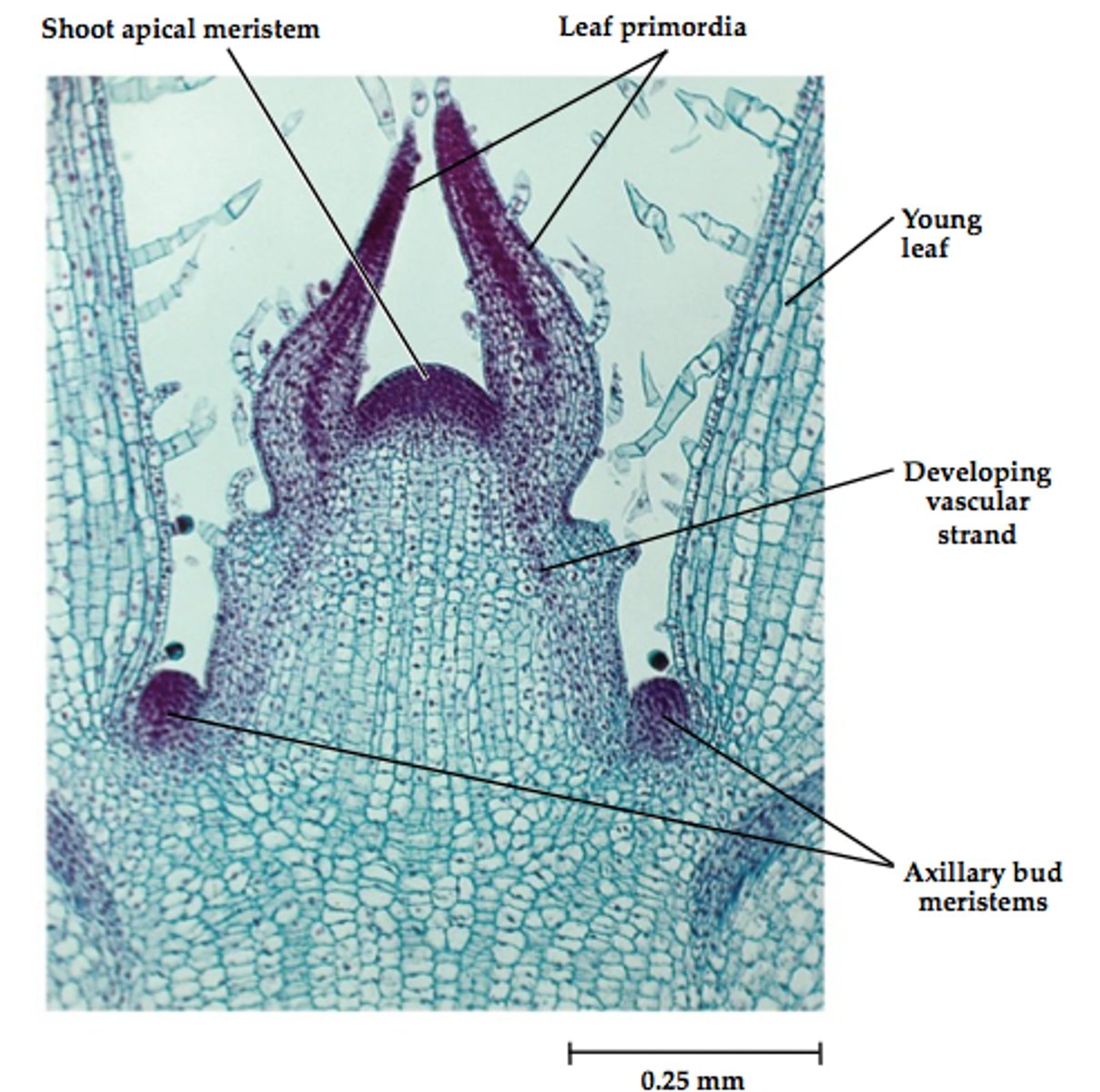
subapical meristem
Region that produces new cells a few micrometers behind an active shoot or apical meristem.
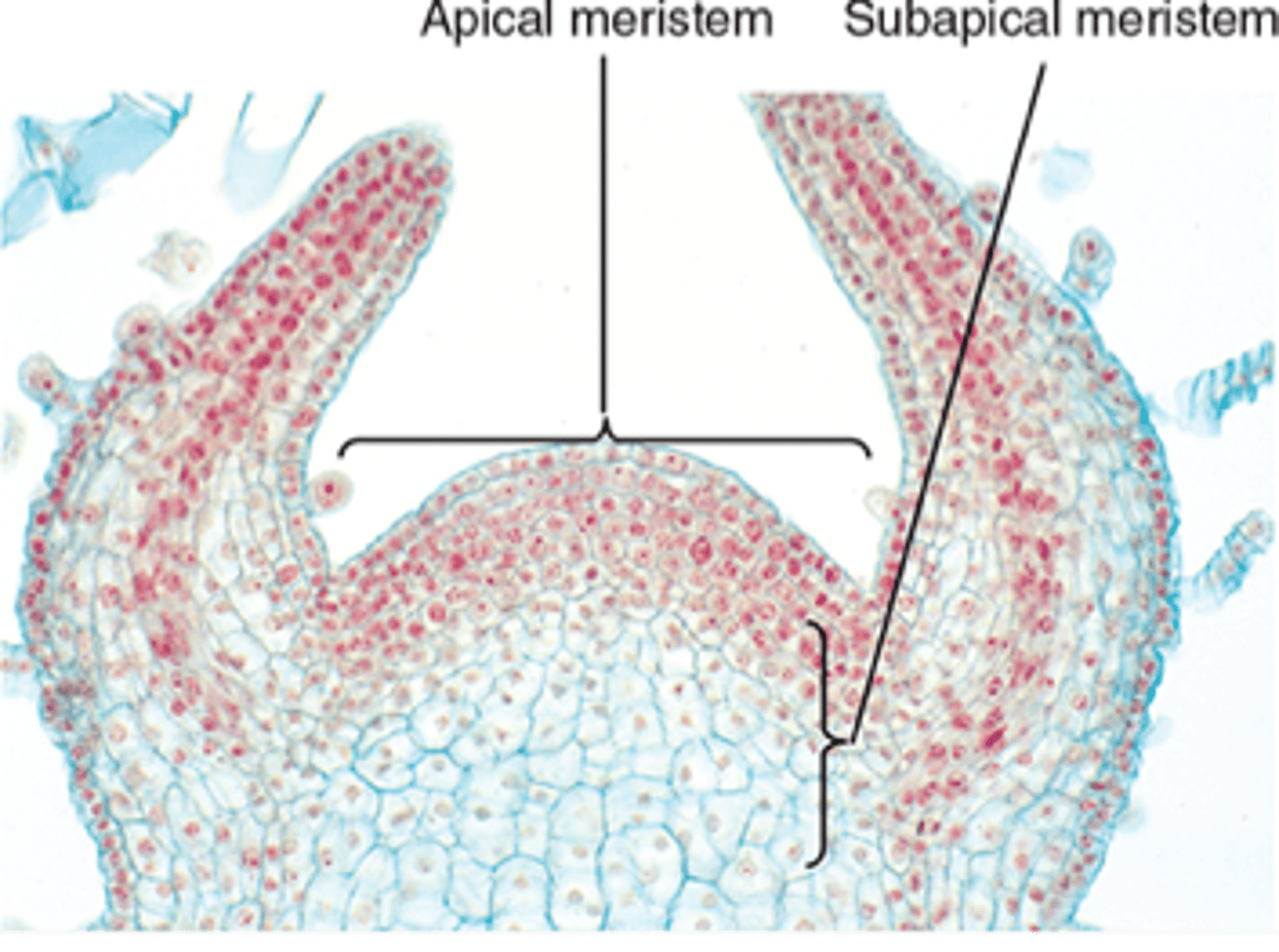
primary tissues are produced by the apical meristem
primary growth and tissue formation that results from apical meristem activity
Secondary growth
Growth produced by lateral meristems, which thickens the roots and shoots of woody plants.
Secondary tissues
derived from lateral meristems called cambia
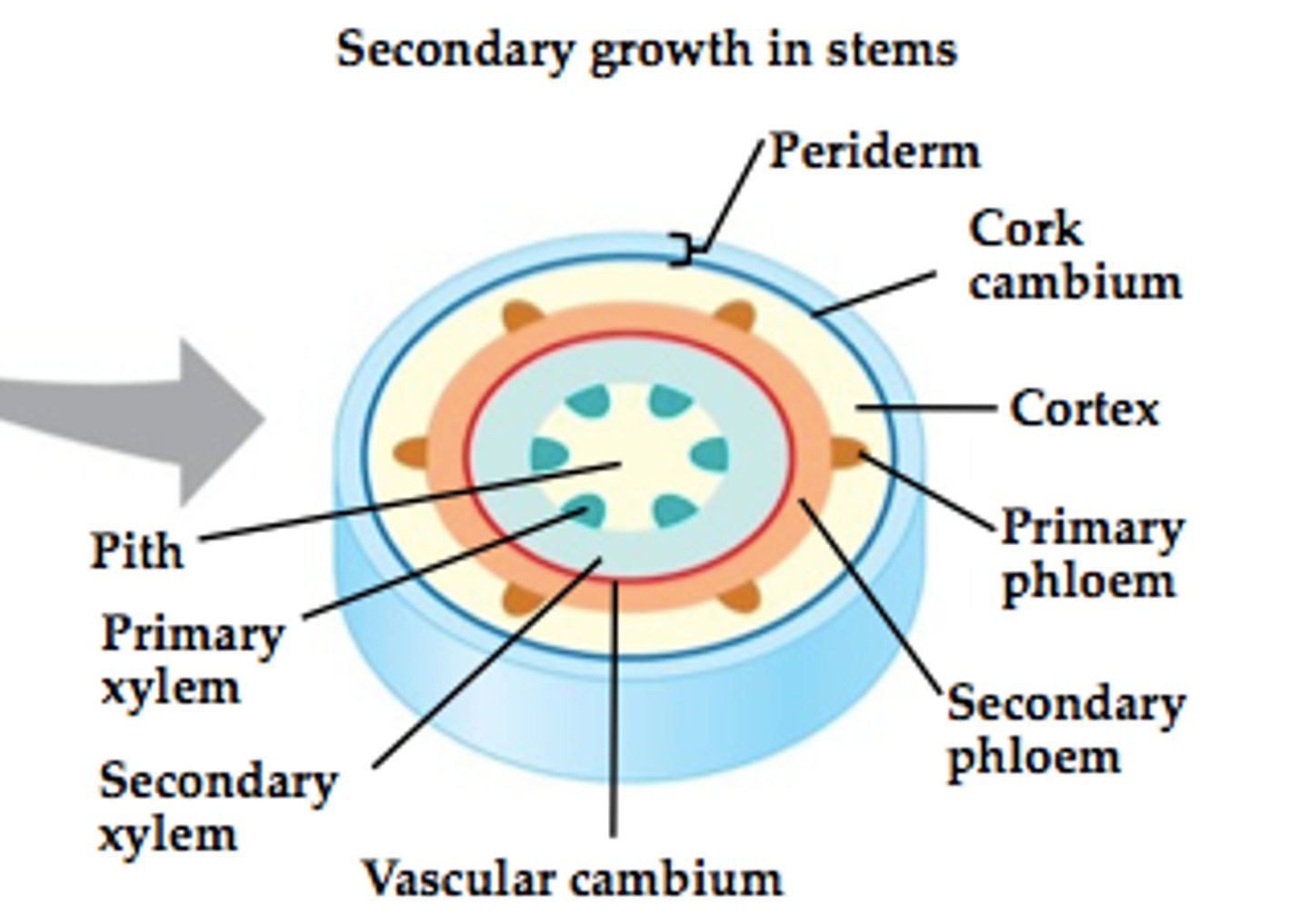
Vascular cambium
produces secondary xylem and phloem (wood)
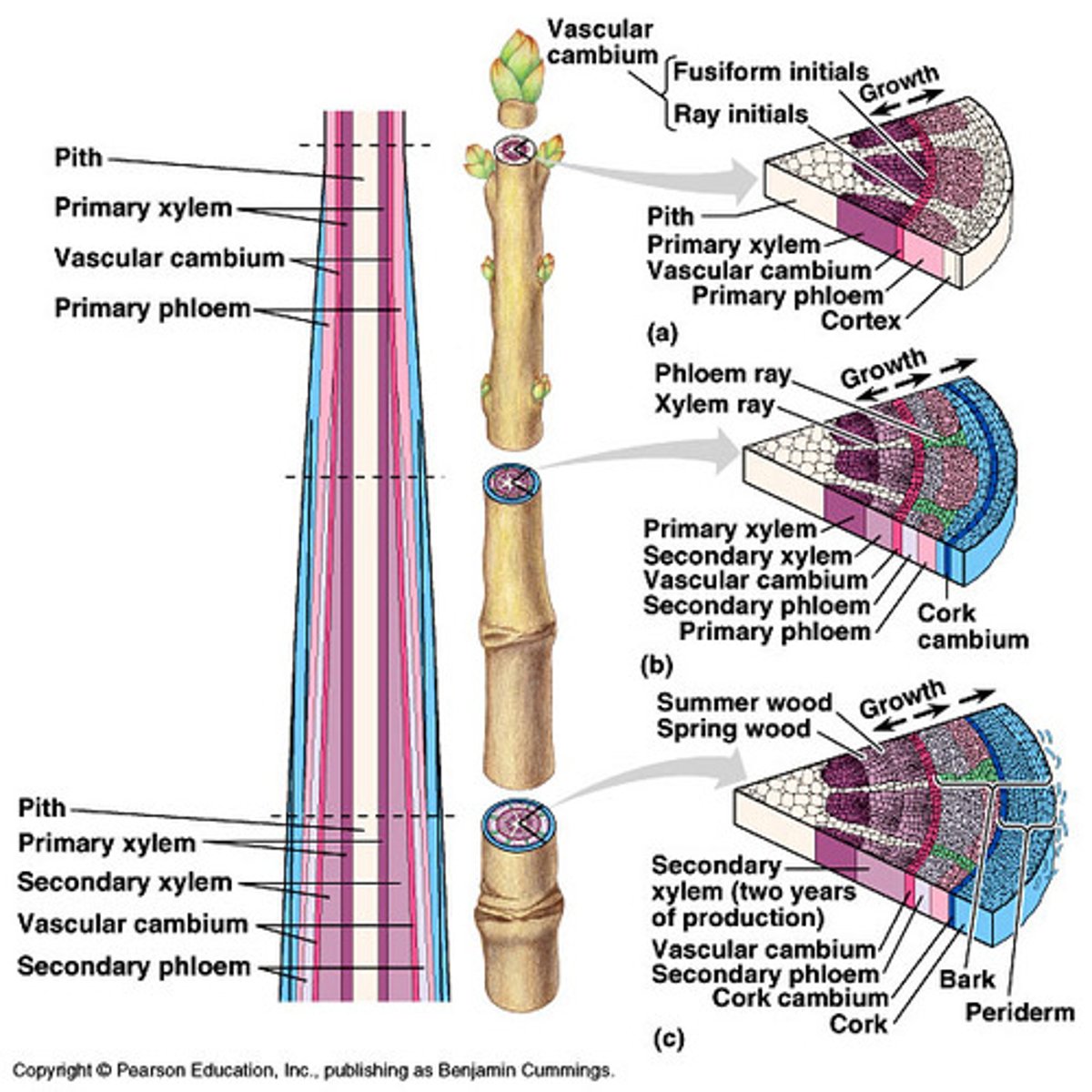
Cork cambium
produces bark tissues that replace epidermis in stem and root
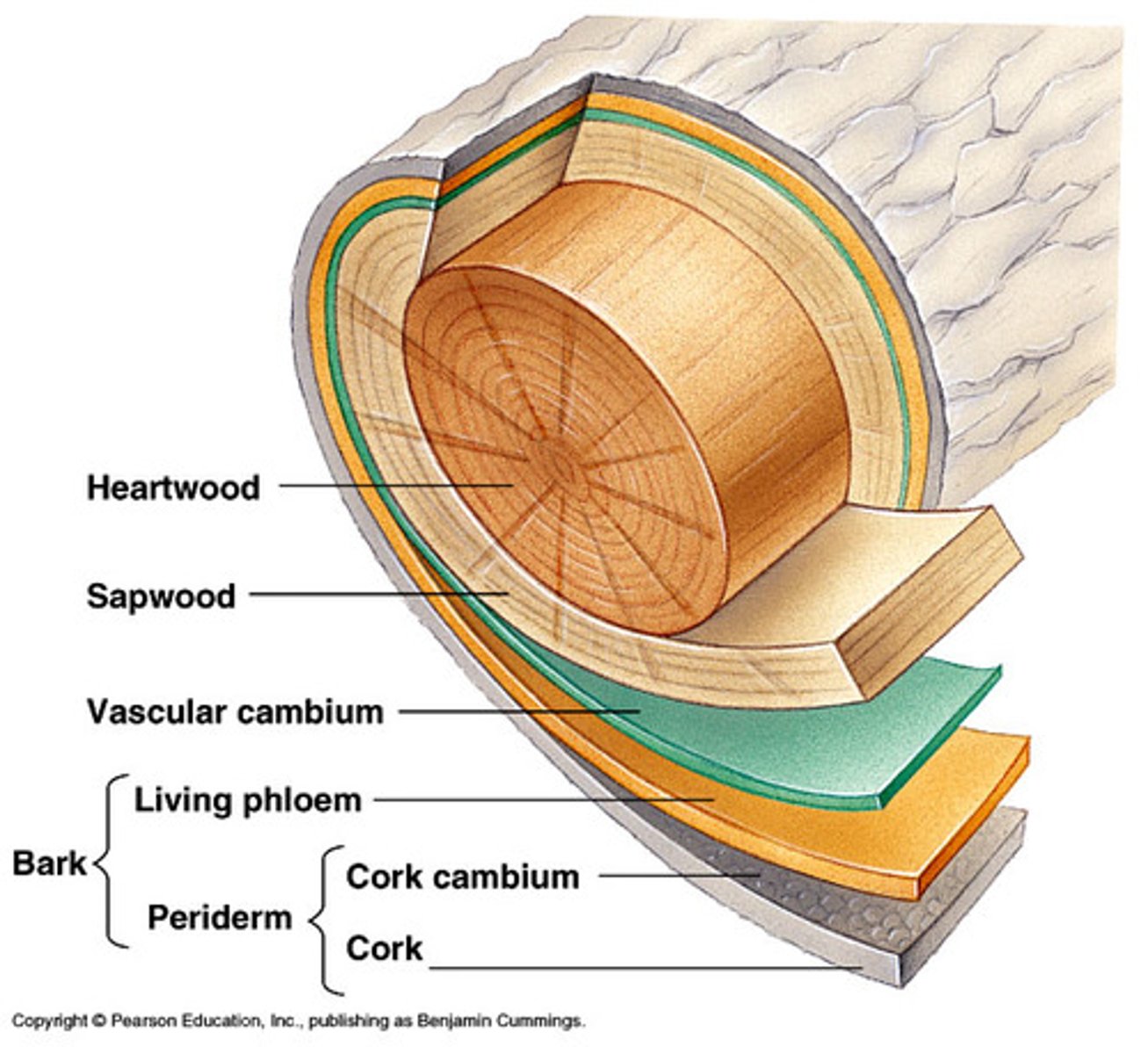
Through more 400 million years of history of plant evolution, woody plants only evolved ______ times
4-6
Where is the oldest tissues of a tree found?
At the pith and furthest from the vascular cambium
Wood rays
group of cells that radially across the stem
Uniseriate rays
one line of cells
Multiseriate rays
multiple lines of cells
Cross section
cut in half (through the center of the pith)
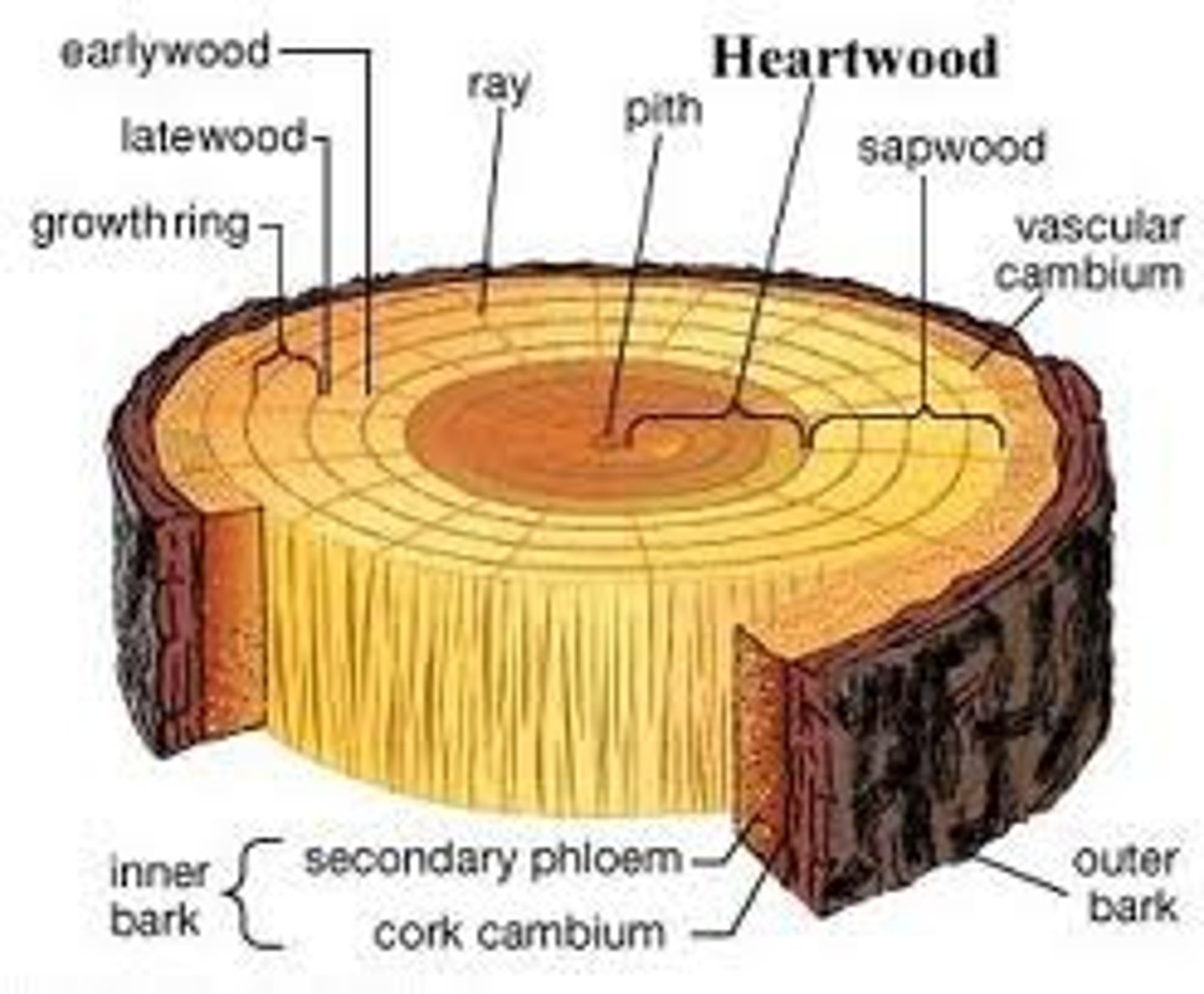
Radial section
longitudinal cuts along a stem or root radius (through the center of the pith)
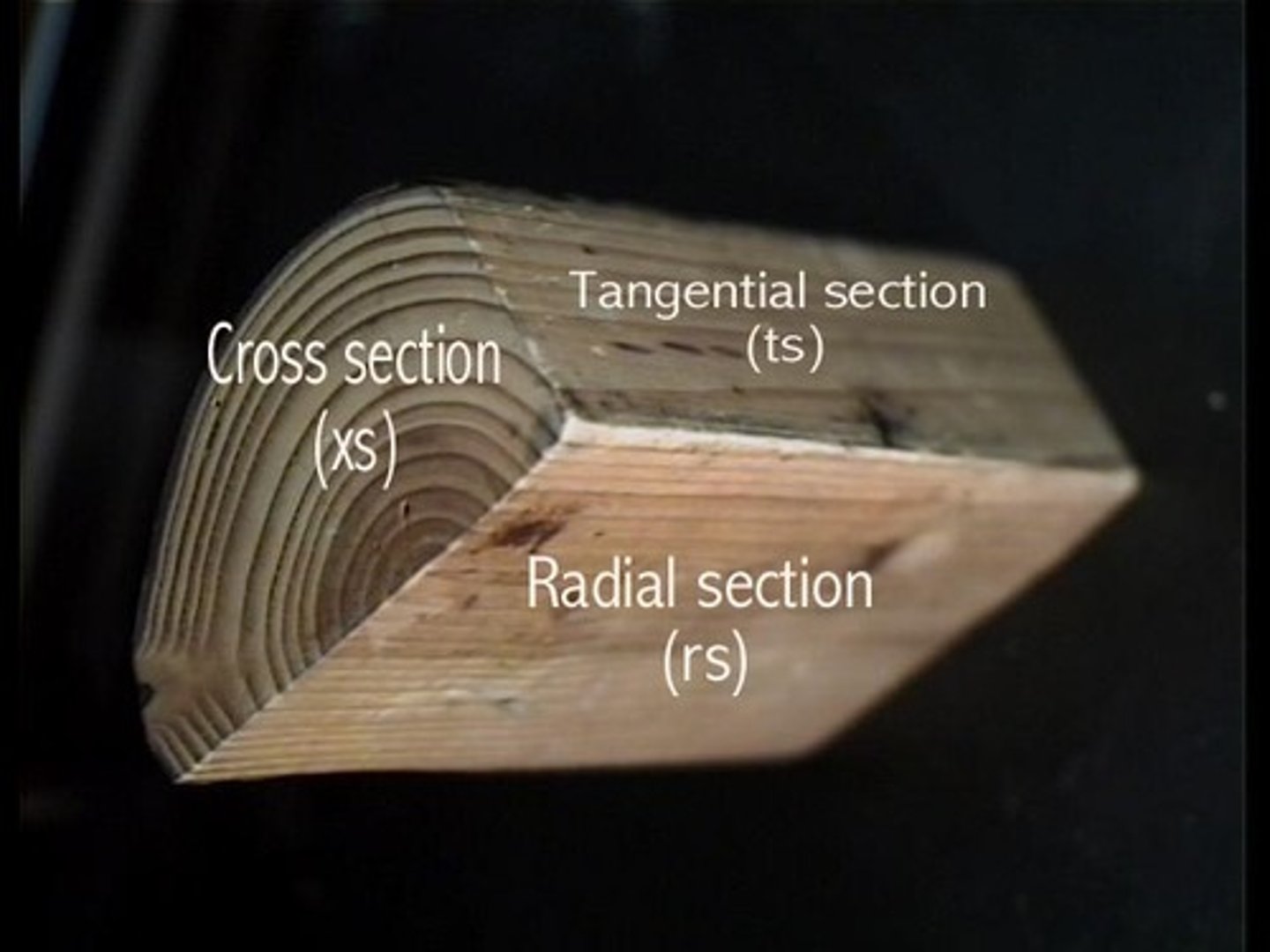
Tangential section
longitudinal cuts that does not go through the center of the pith
Fusiform initials
divides periclinally (and longitudinally) occassionally divide anticlinally (and longitudinally).
Periclinal cell division
produces one secondary cell (xylem or phloem) and one cambial cell
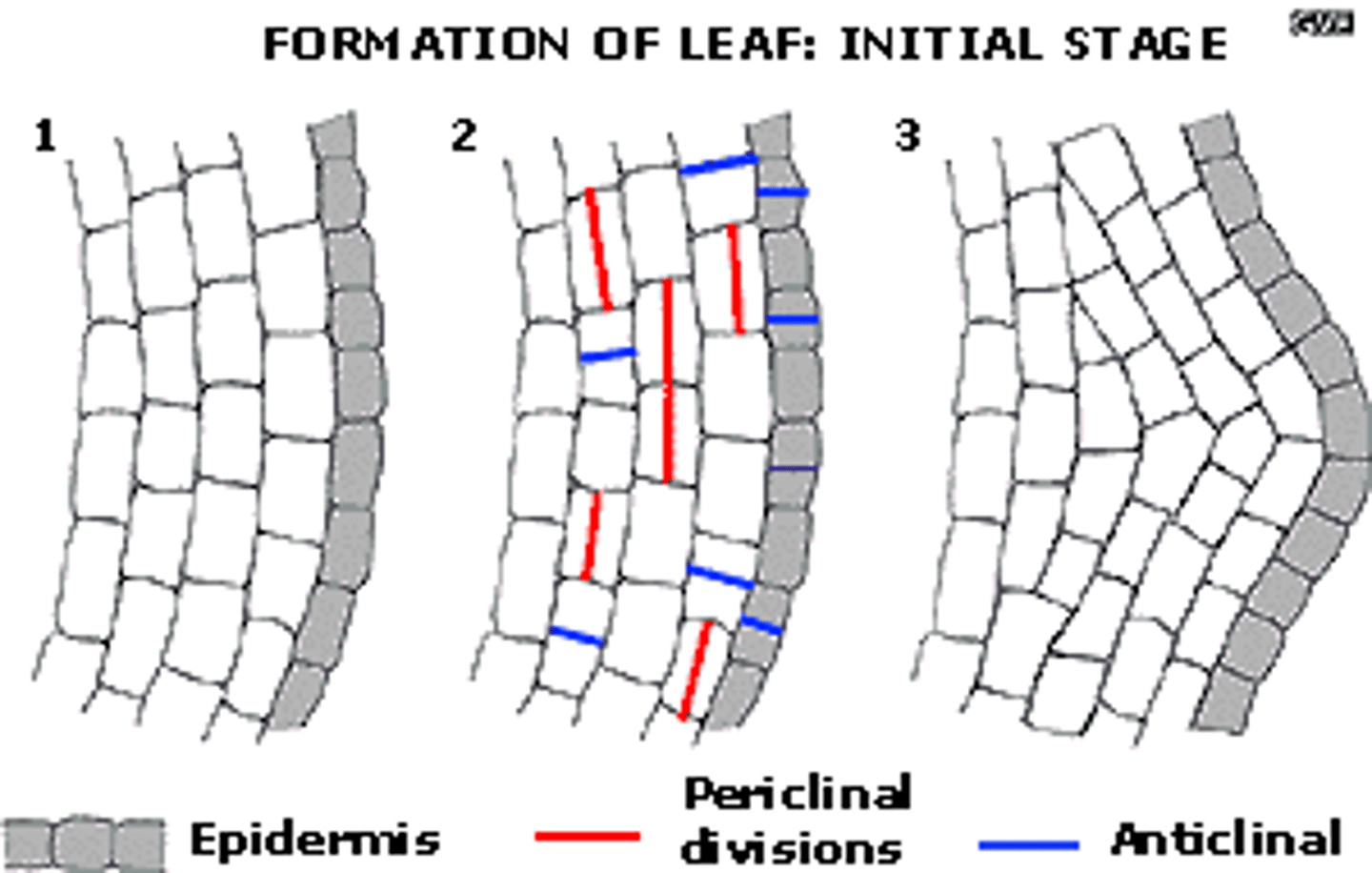
Anticlinal cell division produces
two cambial cells (expands the cambium laterally)
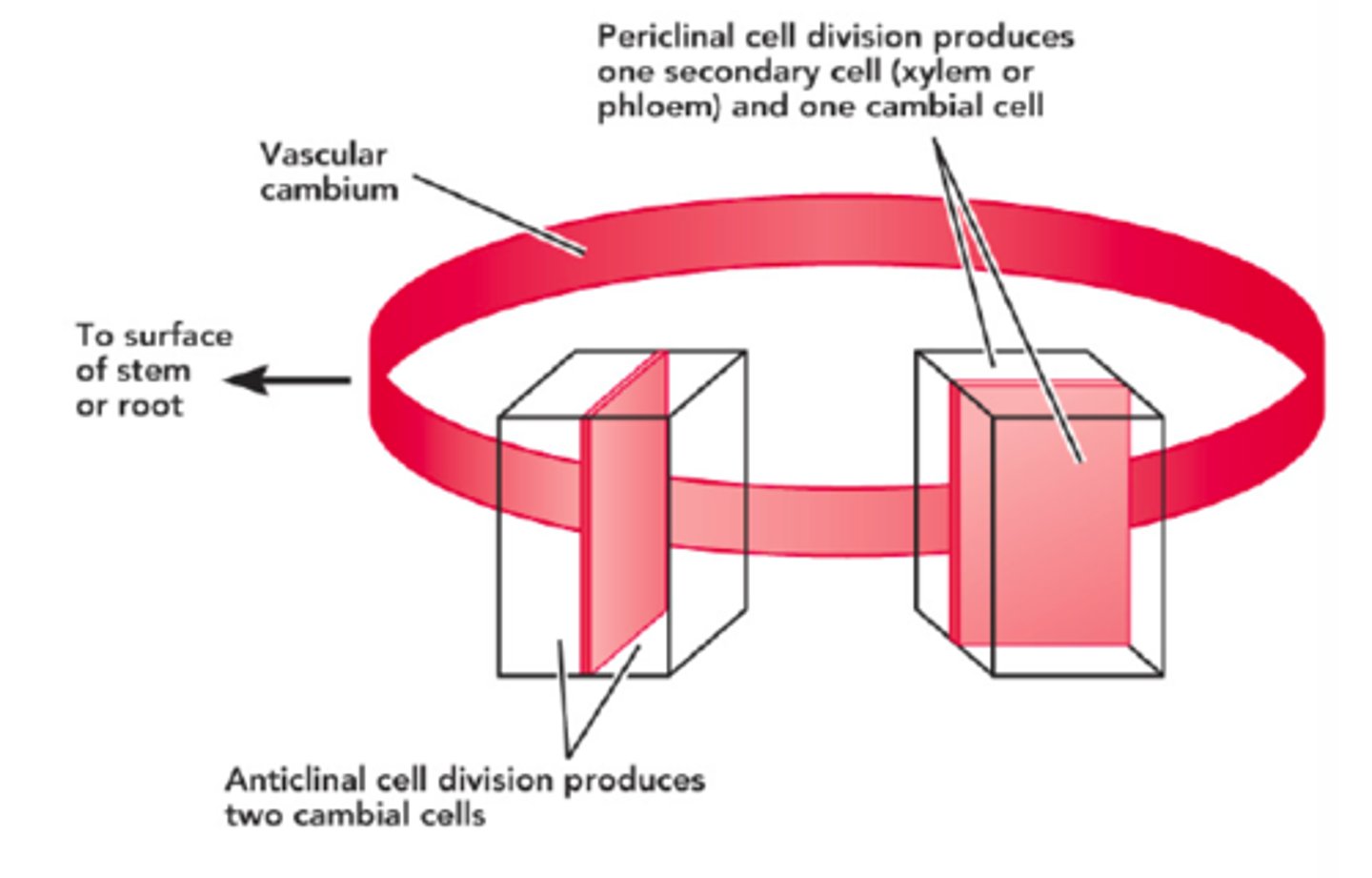
Ray initials divide
periclinally, similar to fusiform inintials (but they are short and cuboidal parenchyma)
Wood cells include:
secondary xylem, rays, fibers, xylem parenchyma, laticifers, resin and gum duct epithelial cells
laticifers
Ducts found mostly in phloem that have latex-secreting cells
Hard wood
tough with many fibers, vessels present, angiosperms
Soft wood
lack of fibers, vessel absent, gymnosperm
Heartwood
dark, heavier, tylosis occurred (in the center)
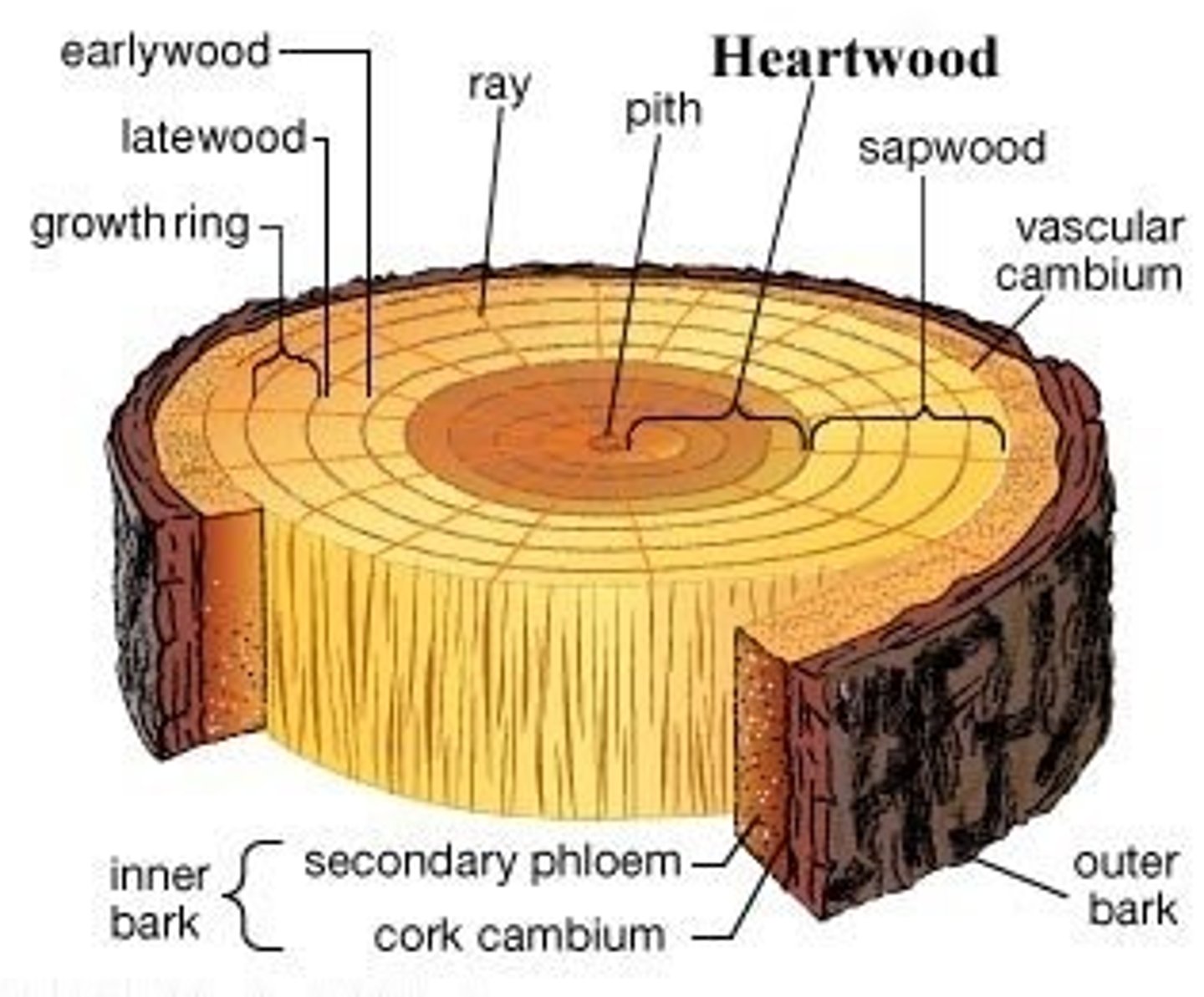
Sapwood
lighter, contains living cells, circles the heartwood
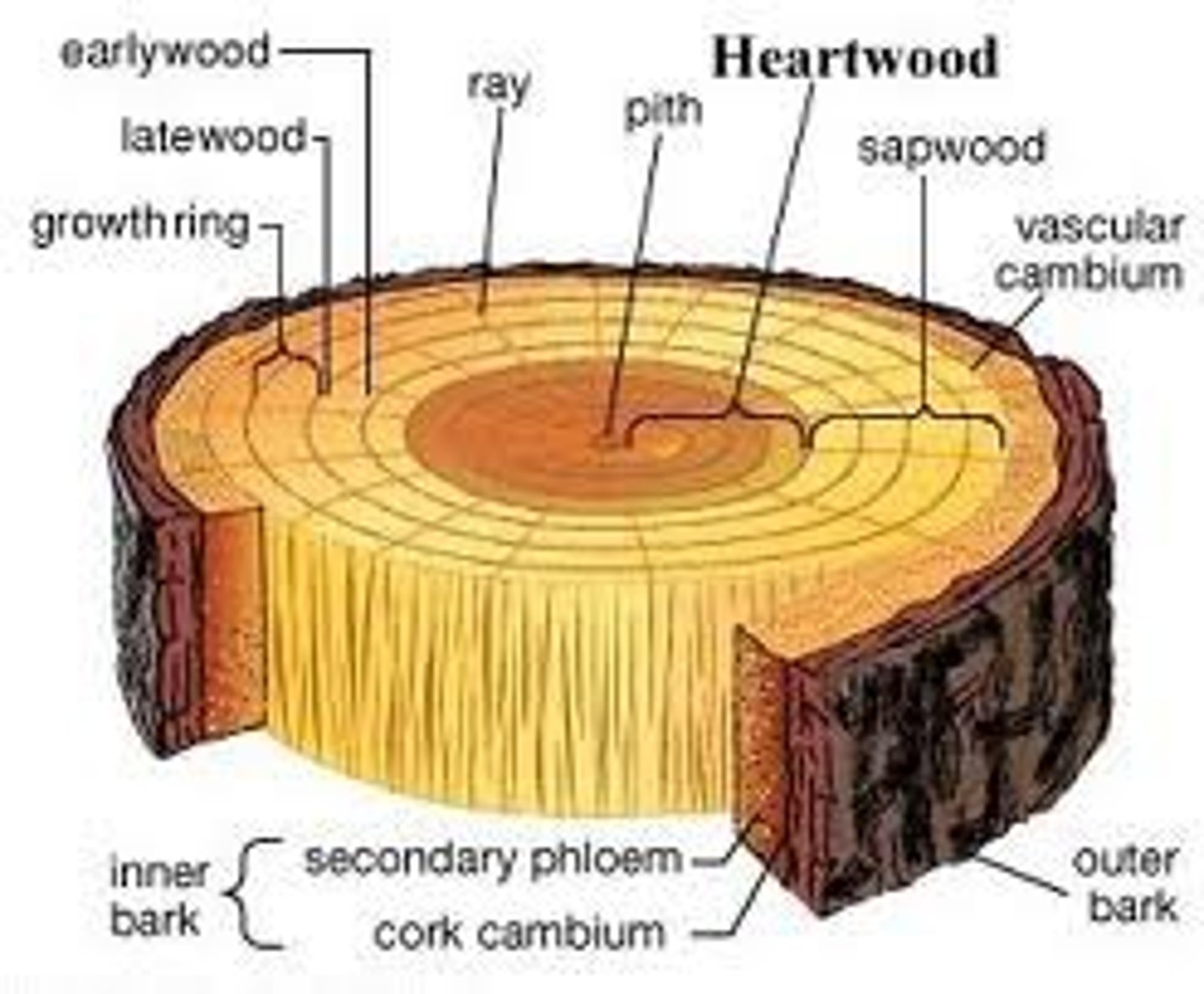
Early wood
formed in the spring, has thin cell walls to maximize water delivery; big cavity
Late wood
formed in late summer, has thick-walled cells and contributes more to stem support; small cavity
Outer bark
outside cork cambium
Inner bark
from cork cambium to vascular cambium
Anomalous growth
refers to unusual or atypical patterns of growth, often due to genetic mutations, environmental stress, or other factors
Herbaceous Plants
no secondary growth
Compare herbaceous and woody plants
Big Woody Trees: Slow-growing, long-lived, invest heavily in defense and structural integrity, produce fewer but larger seeds with slower dispersal methods.
Small Herbaceous Plants: Fast-growing, short-lived, focus on rapid reproduction with many small seeds, and often use quick and efficient dispersal strategies to colonize environments.
4o mini
Woody plants evolved _______ seed plants
before
Progymnosperm
transitional group of plants that resembled conifers because they produced wood, yet still reproduced like ferns (seedless, gymnosperm like cs of wood + fern-like foliage)
Progymnosperm (including the first true tree) evolved _______
in Middle Devonian (420-350 MYA)
What was happening during the Middle Devonian
Earth experienced significant terrestrial plant diversification (rise of the first true trees); was warm and humid
What is a tree?
has a main trunk (main stem); Not all trees are woody plants
What is wood?
Consists of secondary growth, specifically secondary xylem (ex. carrots are wood but not a tree)
Petrified wood
fossilized wood
megasporangium
A plant structure in which megaspores are formed, such as those of the female cones of pines.
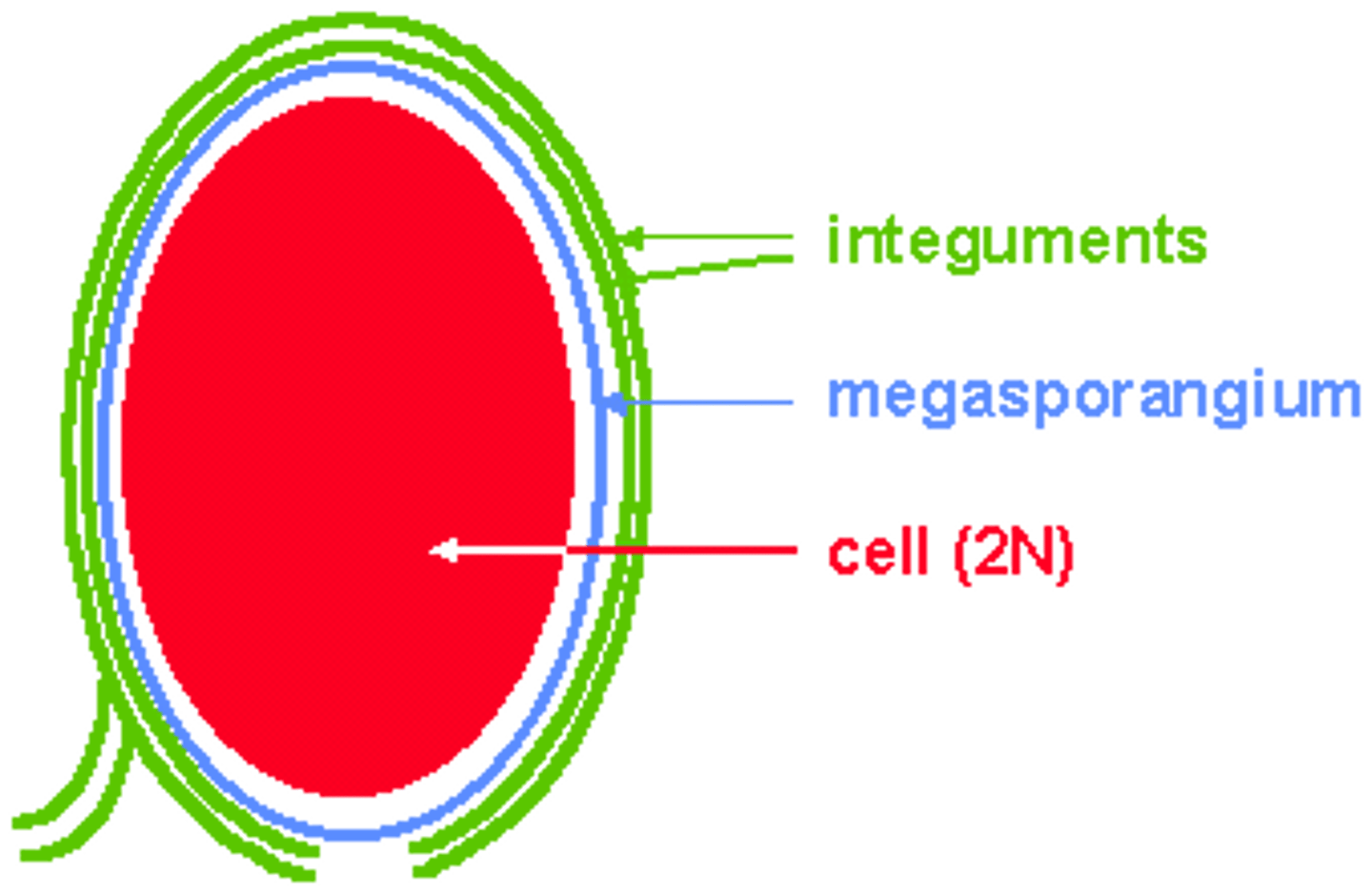
megaspore
A spore from a heterosporous plant species that develops into a female gametophyte.
Explain the origin of the ovule/integument
sterile branches (or structures) fused around fertile ones to form a protective covering that eventually evolved into the integument.
What did these fertile branches contain?
the megasporangium (2n; belonged to sporophyte)
What is the ploidy level of the sterile branches?
2n since they belonged to the sporophyte (became the integument)
Why is the megaspore only one N?
The megasporangium undergoes meiosis to produce the megaspore
The female (mega-) gametophyte is what ploidy level?
N (gametophyte is only haploid)
The embryonic sporophyte is 2n because
it's fertilized and results from the fusion of two haploid gametes
Gymnosperm
"naked seeds"; seeds develop on the surface or tip of an appendage, not encased within it; no fruits
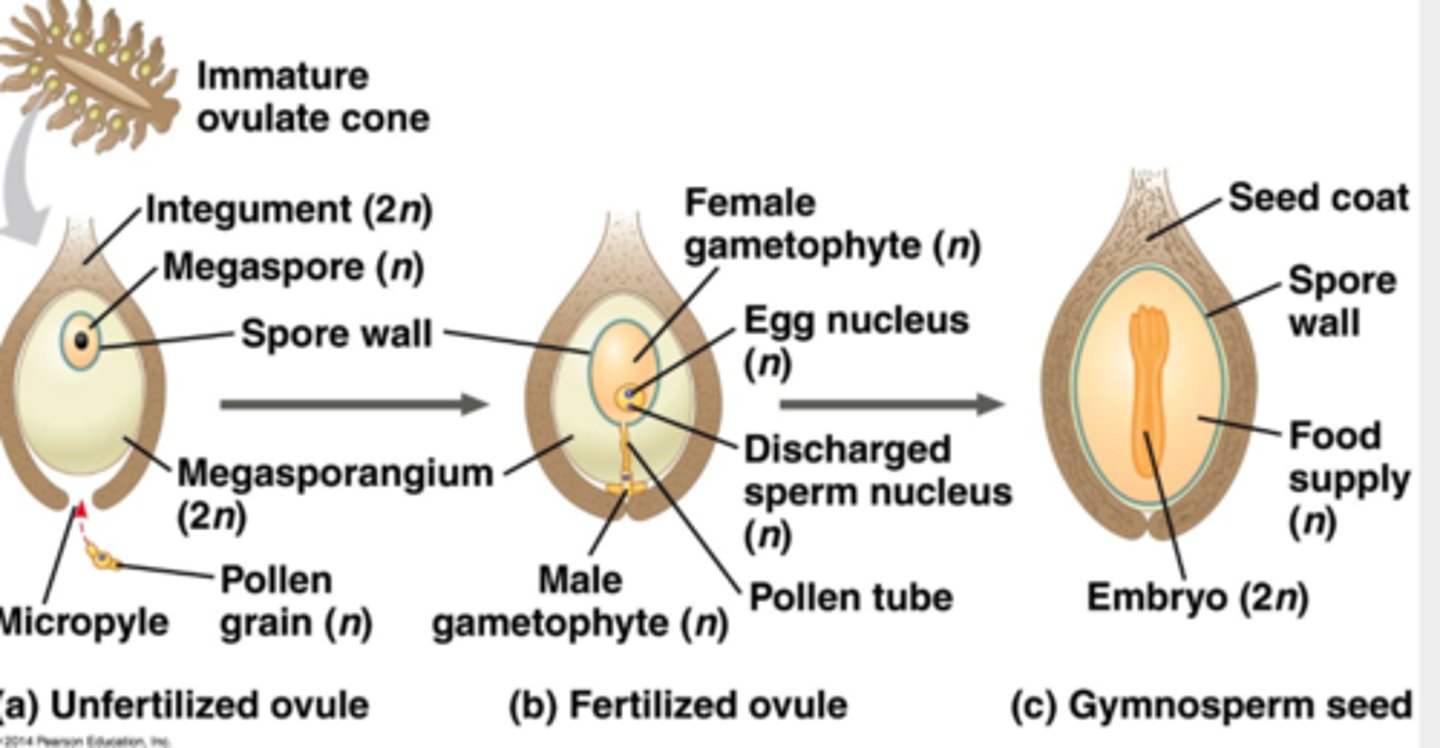
Angiosperm
"clothed seeds"; seeds develop within the fruit; later fruits may open and release seeds but early seed development is completely within the fruit
Are seed plants heterosporous or homosporous?
All seed plants are heterosporous
Are seed plants endosporic or exosporic gametophytes?
endosporic gametophytes; both male and female gametophytes develop inside the spore wall (the gametophytes remain enclosed and protected by the sporangium or seed structures)
Four potential megaspores are produced in the megasporangium through meiosis
only ONE becomes the functional megaspore (other 3 degenerate)
Megasporangium is surrounded by a special covering called
integument
megasporangium (nucellus) + integument =
ovule
micropyle
A pore in the integuments of an ovule
megaspore
A spore from a heterosporous plant species that develops into a female gametophyte.
the functional megaspore develops into
female (mega-) gametophyte inside the ovule; never released into the environment; endosporic but not thick-walled; mature female gametophyte produces egg(s_
Developing male gametophyte and its surrounding microspore wall are released/shed as
pollen grain
transfer of pollen to region near ovules
pollination
Pollination does not equal fertilization
TRUE; not all pollination leads to fertilization since some pollen may fail to germinate
Fertilization and early development of next-generation sporophyte occur within female gametophyte
which is still inside the ovule (integumented megasporangium)
seed
mature ovule + developing embryonic sporophyte
In gymnosperms
pollination involves transfer of pollen grains (male gametophyte) directly to the micropyle of the ovule
How do seeds disperse?
windblown fruits, aherent fruits, fleshy fruits (through wind, animals and water)

Gymnosperms include
Seed ferns, cycads, ginkgos, conifers, gnetophytes
Pteridospermatophyta (Extinct "seed ferns")
seeds + fern-like fronds: somewhat look like cycads or tree ferns. Seed fern is not a tree fern
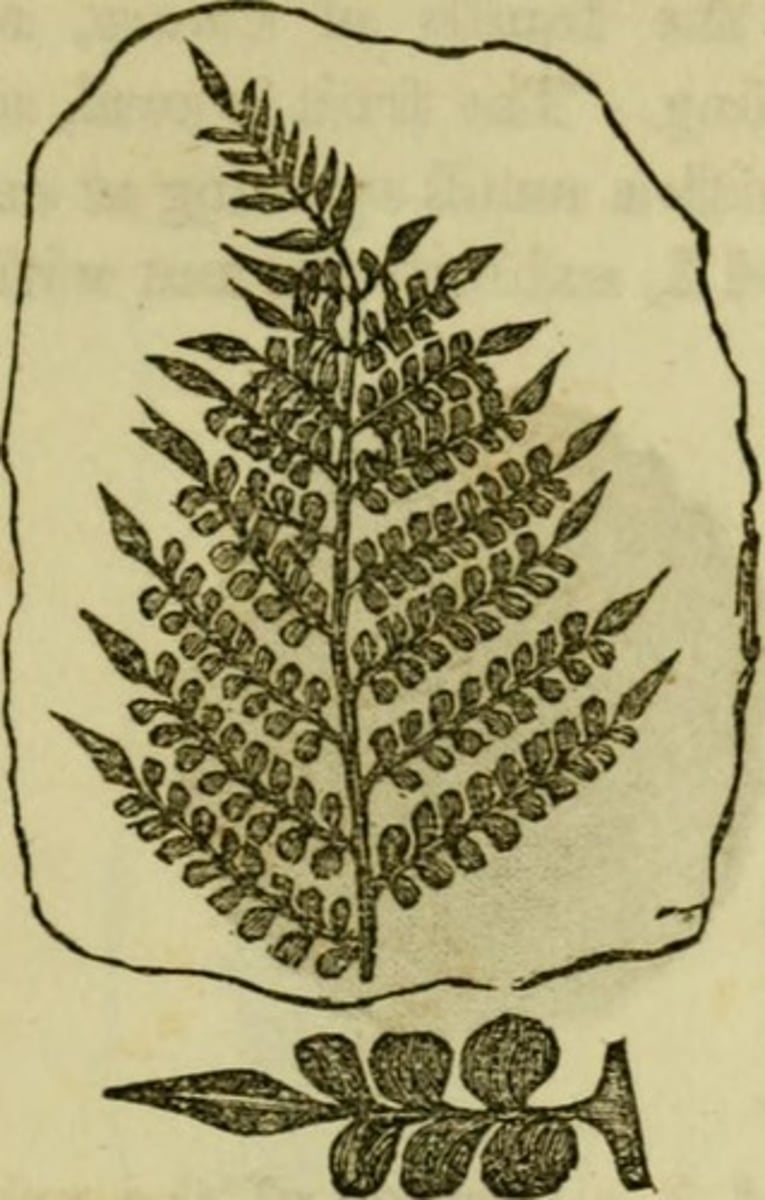
Key Features of cycads
- commonly shoot unbranched
- large leaves
- dioecious: pollen cone plus various seed cone
- large pith and cortex
- little secondary xylem but a lot of parenchyma (similar to seed ferns)
Ginkgophyta (Ginkgo)
Living fossils; a living species strikingly similar to a species only known from fossils
Key Features of Gingko
- dioecious
- slow growth in early years
- medicinal purposes
Coniferophyta (conifers)
phylum that includes seed plants that form cones; biggest of the gymnosperm; well adapted to cold and dry place
Dioceious
having the male and female reproductive organs in separate individuals.
monoceious
having both the male and female reproductive organs in the same individual
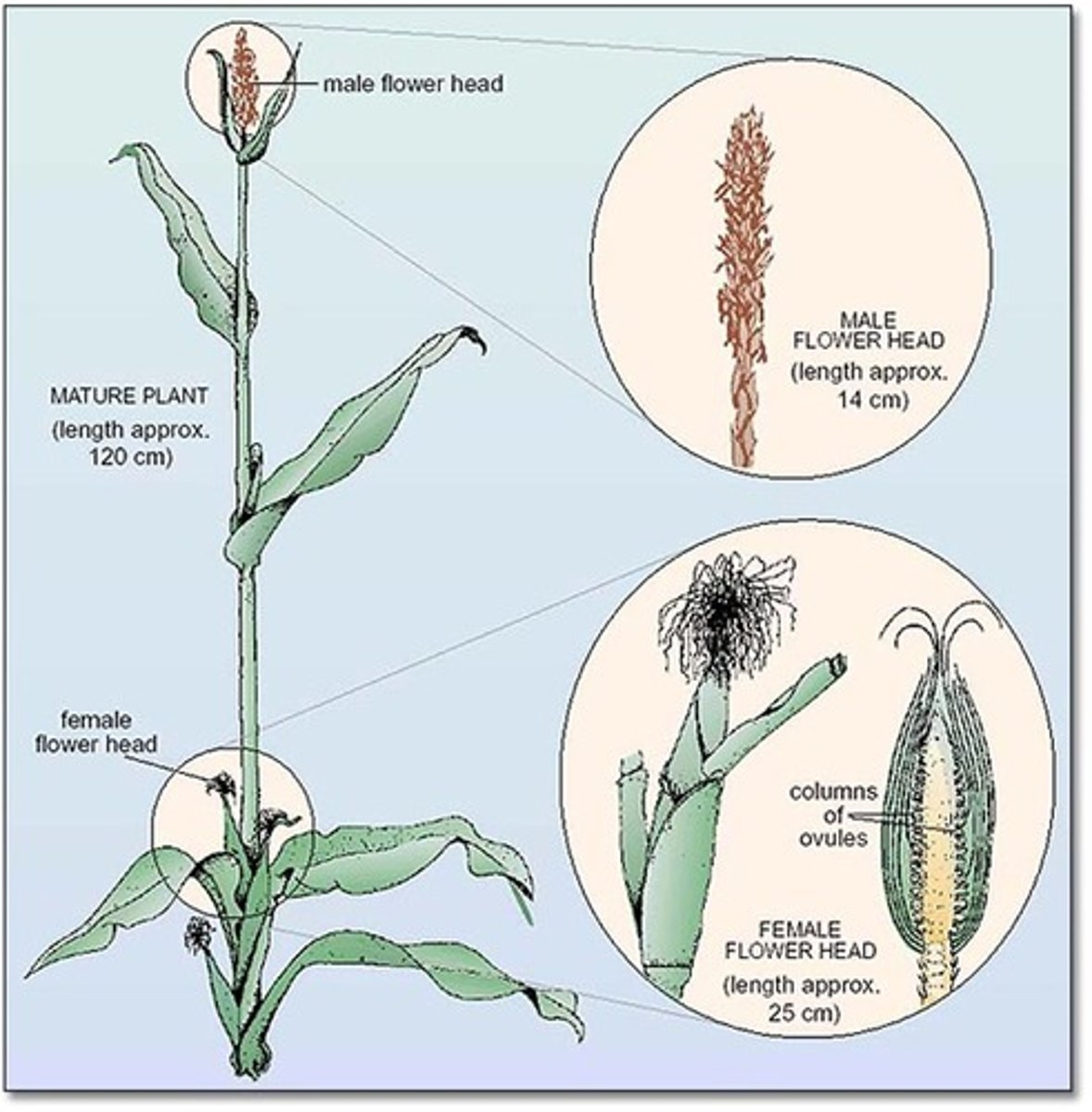
What is in a pollen grain
• Microspores develop into pollen grains, which contain the male gametophytes
• Pollen grains have a generative cell which produces the sperm and a tube cell which produces the pollen tube. If a pollen grain germinates, it gives rise to a pollen tube that discharges two sperm into the female gametophyte within the ovule
Gnetophyta
- monophyletic
- contains 3 families, each with only one genus
- relationship with angiosperms is not certain
What makes gnetophyta different from the rest of the gymnosperms?
primitive vessels in wood, no archegonia, naked eggs, evidence for "double fertilzation" and origin of endosperm
microspore
A spore from a heterosporous plant species that develops into a male gametophyte.
flowering plants (angiosperms)
largest group of land plants that all have: flowers, carpels, fruits, double fertilization with triploid endosperm, specialized conductive cells
How do angiosperms differ from gymnosperms?
they're seed plants BUT ovules are contained WITHIN a structure (pistil) that will become the fruit
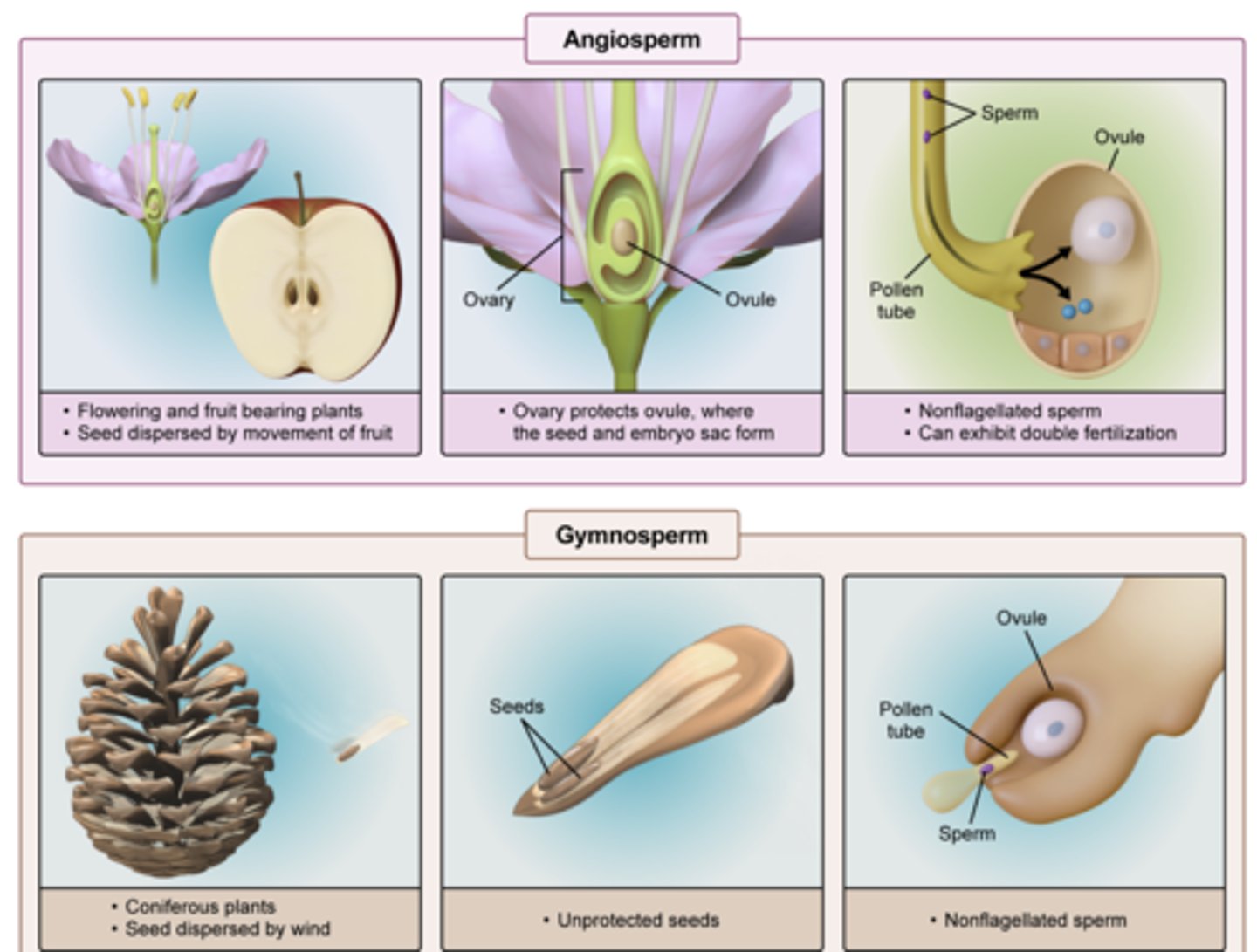
Carpel
evolutionary equivalent of a single megasporophyll
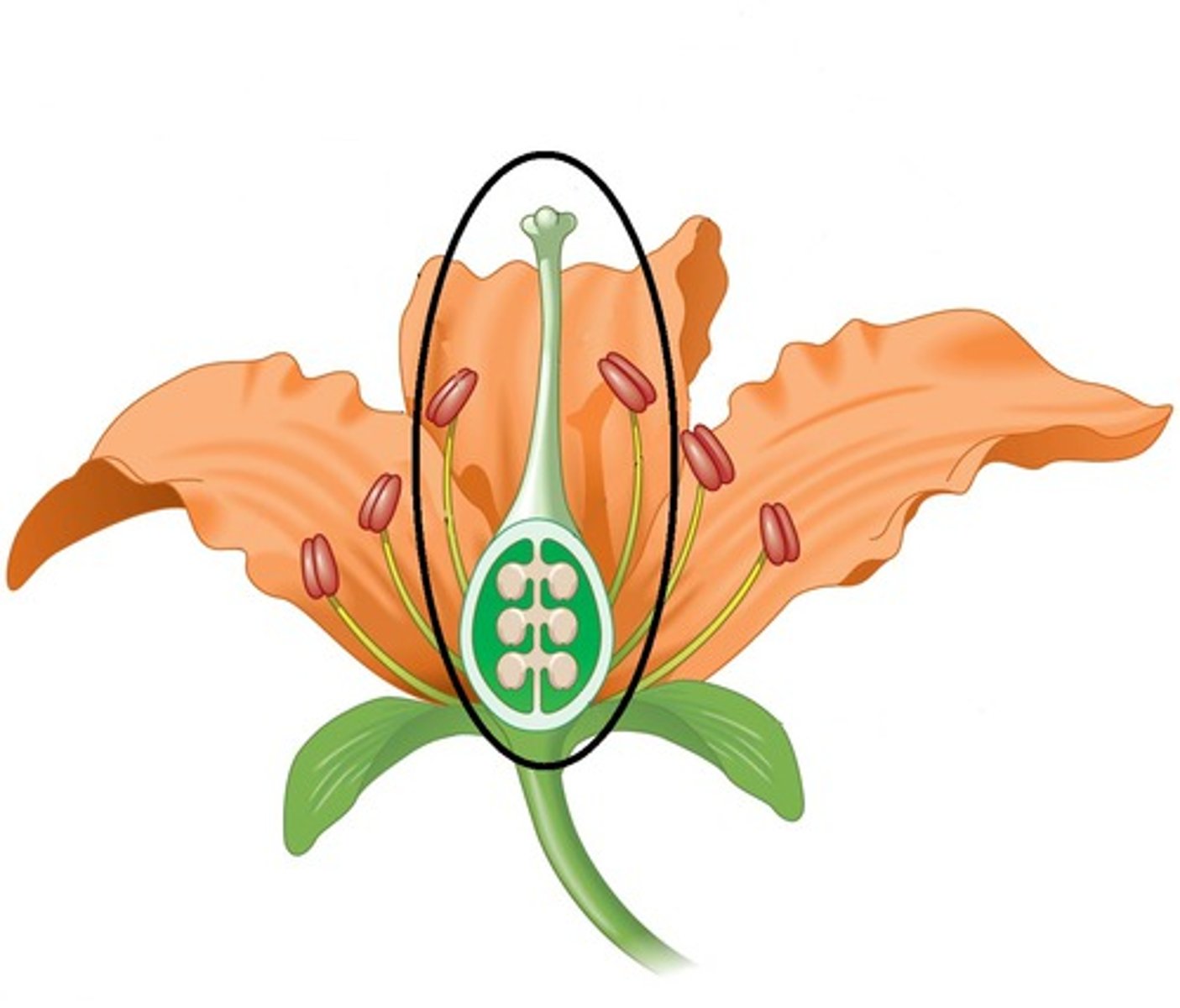
Pistil
one or more folded megasporophylls, evolutionarily (thus, it consists of one or more carpels) Develops into the fruit (multiple carpels make up one pistil)

In angiosperm, the pollen germinates on the
pistil, not directly on the ovule
In angiosperms, male and female gametophytes further reduced (fewer cells)
form seeds in weeks or even days
In angiosperms, two sperm cells produced but BOTH function in fertilization process
this is double fertilization
Where do both sperm cells do in double fertilization?
One fuses with egg (2N zygote); One fuses with two nuclei of central cell of female gametophyte (3N Endosperm)
3N Endsoperm
tissue that nourishes embryo (not mega-gametophyte tissues); endosperm feeds the world
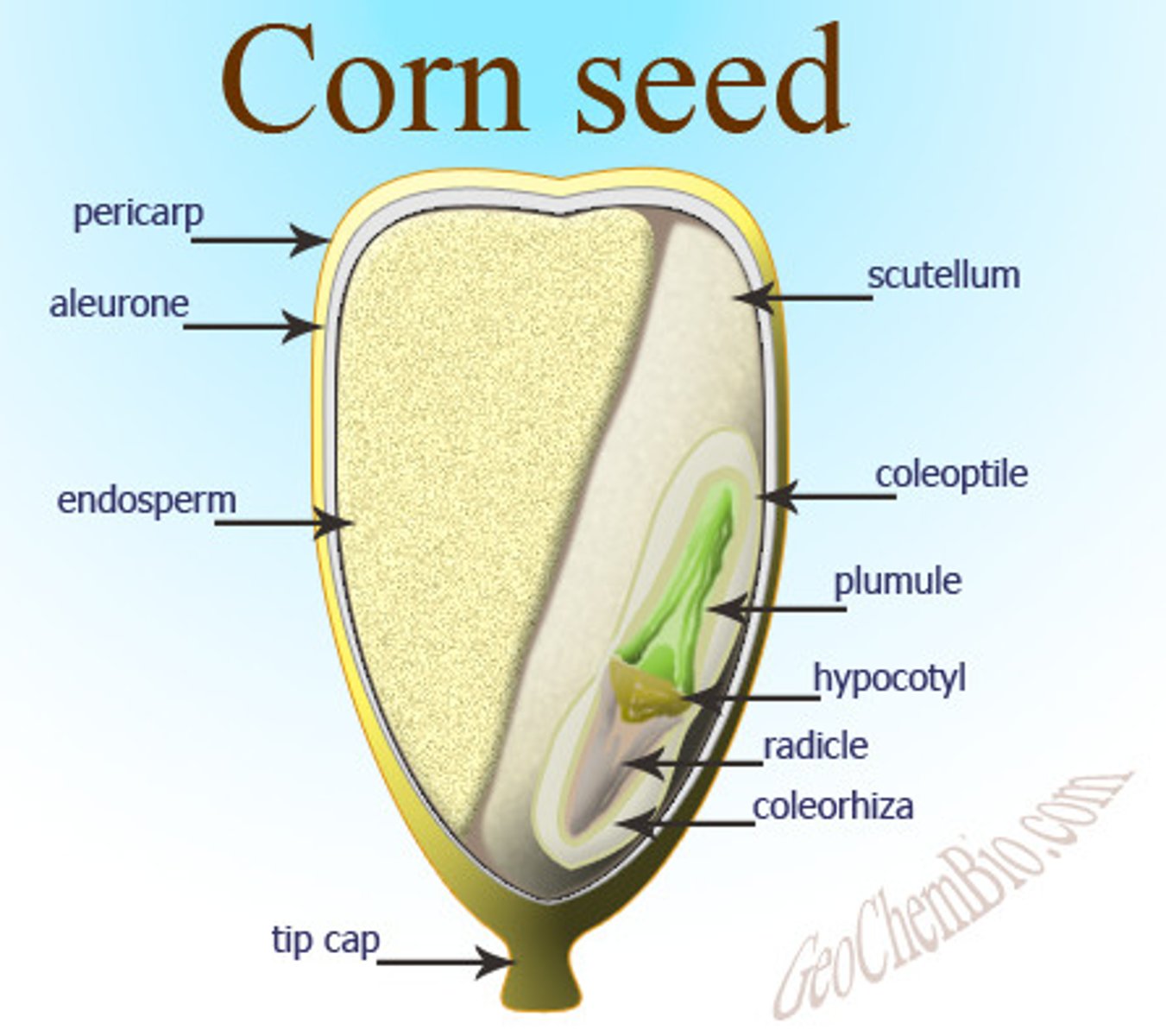
Endosperm is found in (3n)
angiosperm (from double fertilization)
Megagametophyte tissue (n)
Gymnosperm (comes from the megaspore)
Both serve as nutrients for the embryo
but have different origins
Angiosperms have the presence of
the flower
Steps of female gametophyte development
1. diploid megaspore mother cell forms inside ovule's nucellus
2. this undergoes meiosis, producing 4 haploid megaspores
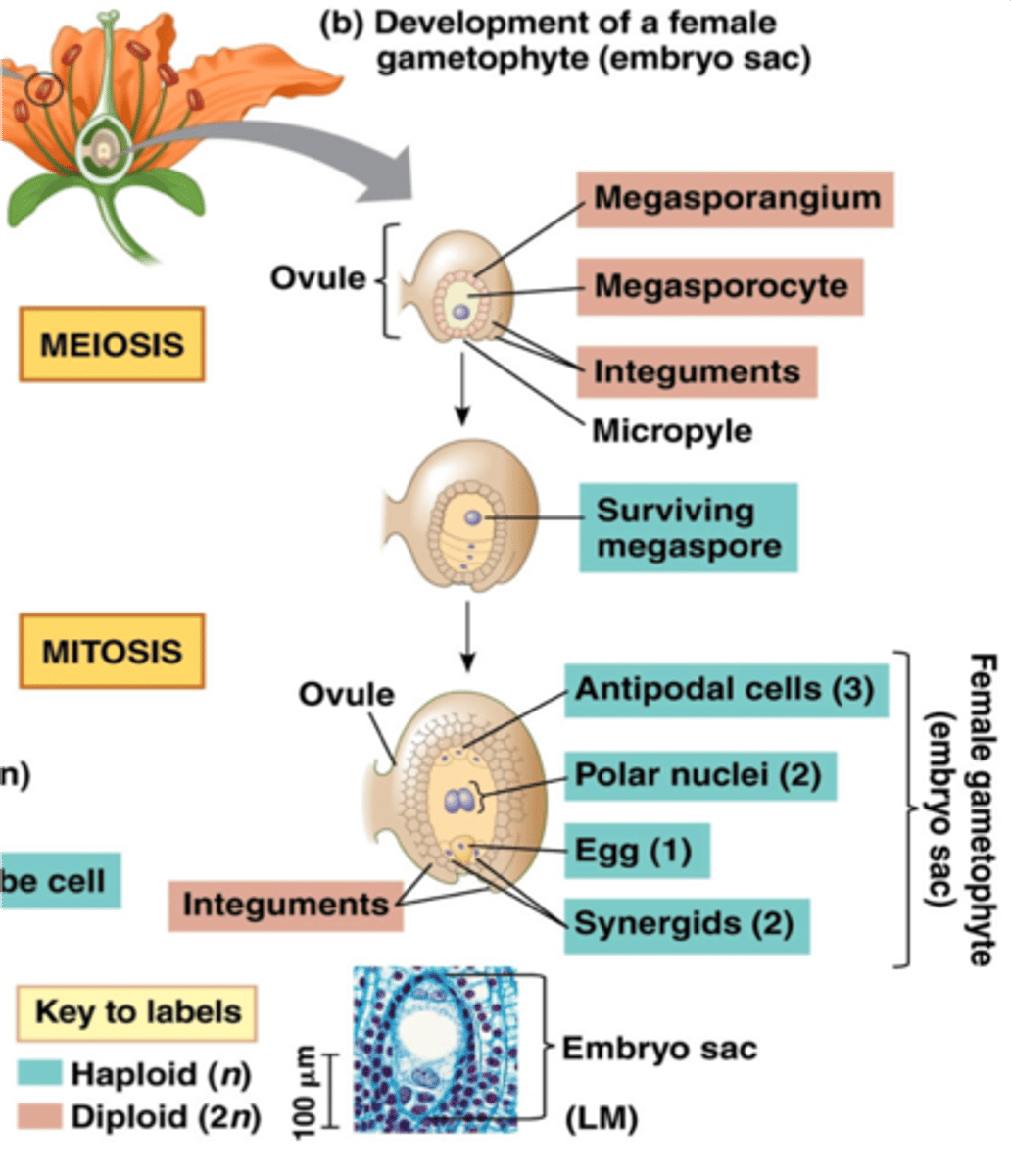
Of the 4 megaspores,
3 degenerate, leaving one functional megaspore
This functional megaspore undergoes how many rounds of mitotic divisions?
3 rounds, resulting in 8-nucleate.